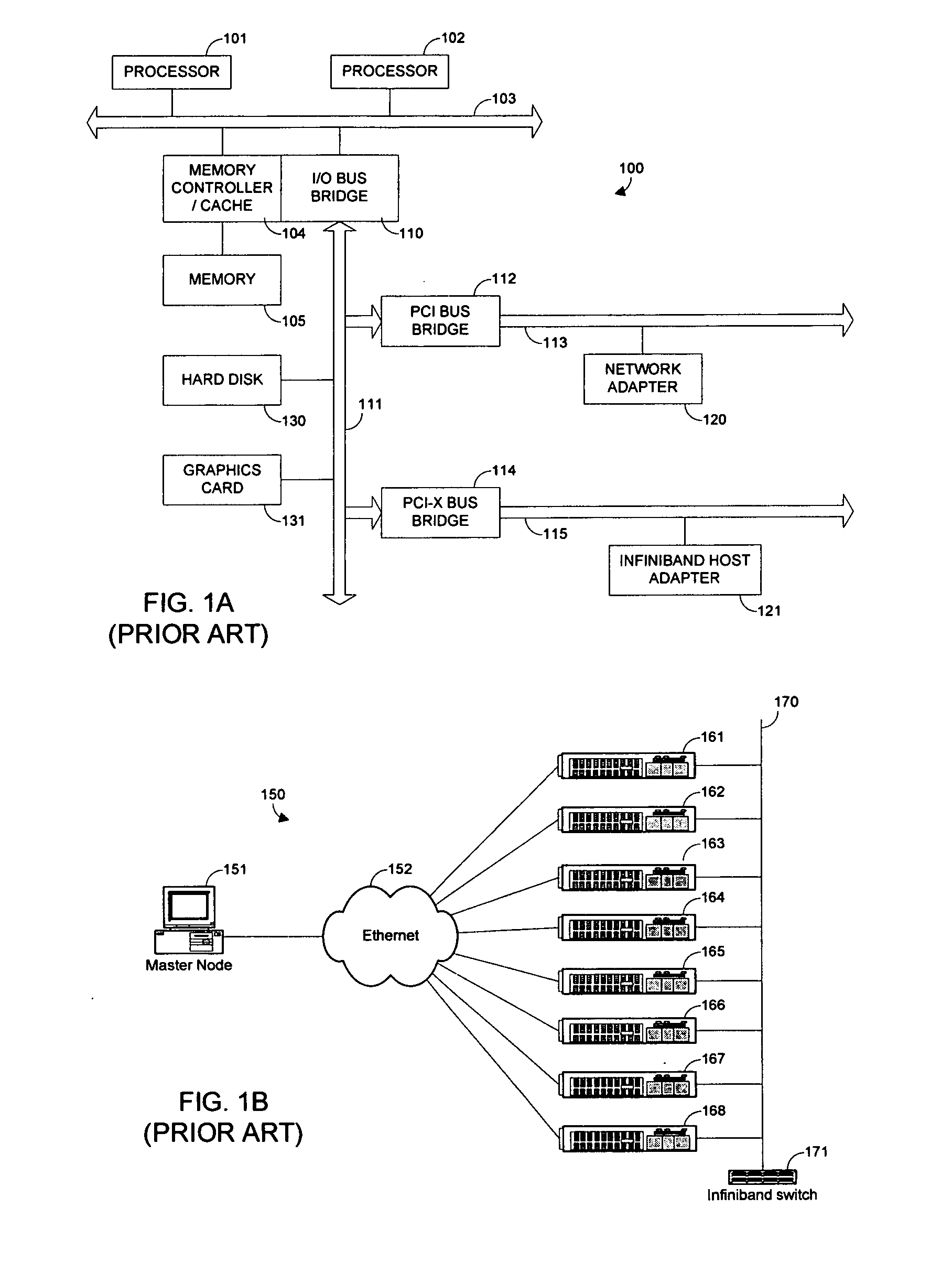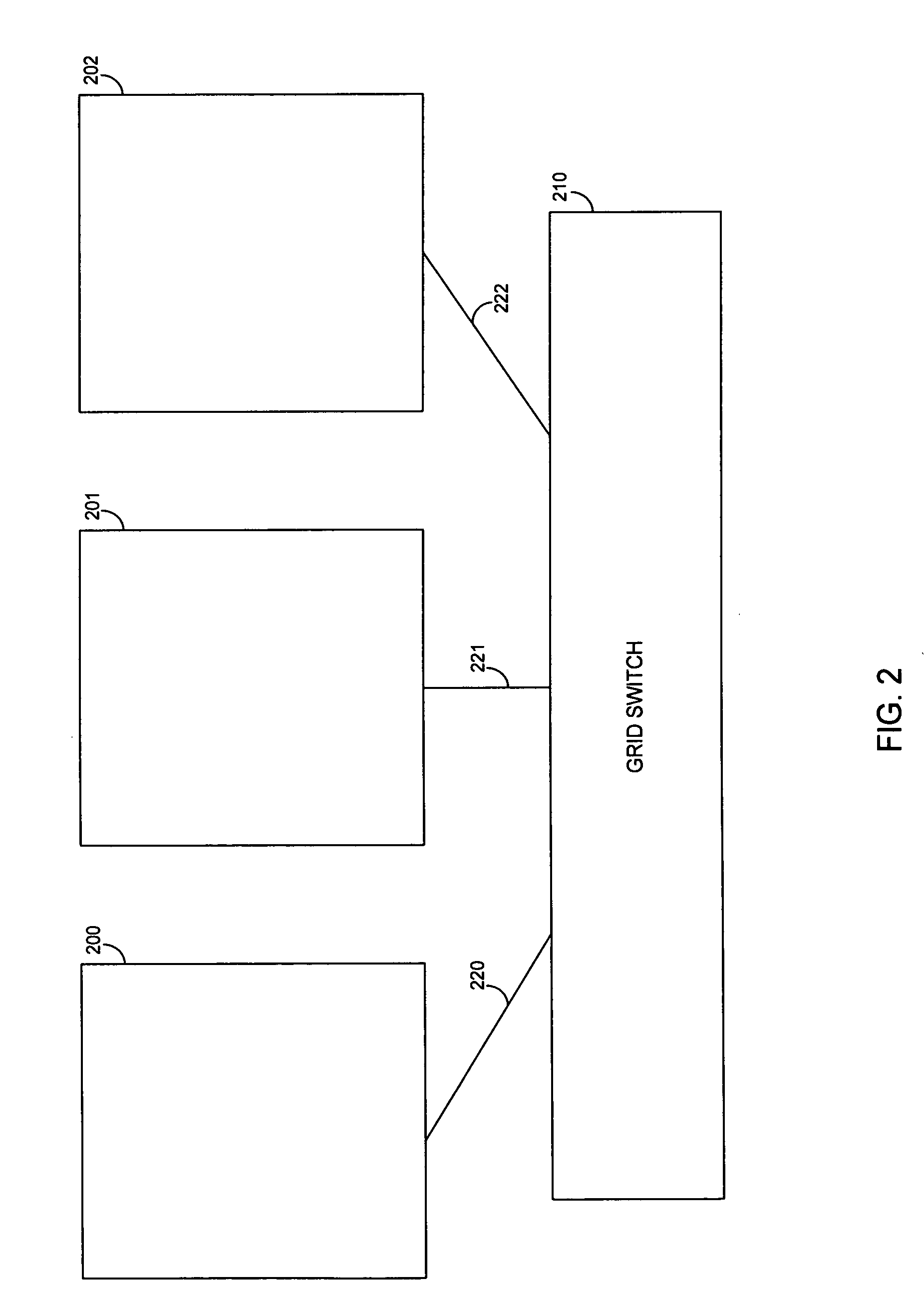Despite the continuing rapid advancement in processor performance, the need for computing power tends to outpace the available processor performance.
As more processors are added in an SMP systems, both the
shared memory and the interconnect through which processors access the memory quickly becomes a
bottleneck.
This
bottleneck limits severely the
scalability of the SMP architecture to a fairly low number of processors, typically between 2 and 8.
The drawback of a NUMA
system is that performance sensitive programs perform very differently depending on where data is placed in memory (i.e., local or remote relative to the processor that executes the particular thread).
Both SMP and NUMA computers, however, are limited in the number of processors that can be included in a single computer and share its memory by the huge
impact of the interconnect latency on the aggregate performance of the system.
While some 1,000 processor NUMA installations exist, such as the SGI Altix, they depend on an expensive, proprietary interconnect that typically costs more per processor than the actual processors they connect, and scale to a very limited (e.g., 256) number of nodes.
Further growth of the systems is limited by a number of fundamental factors, the most significant of which is the need for a store-and-forward switching architecture of the interconnect, which immediately introduces latencies in the order of 10-20 microseconds or more.
These approaches provide only incremental improvements in performance, usually mitigated by the increased complexity of the system and quickly wiped out by advances in
mass-produced hardware technologies.
Under all three of the existing
shared memory multiprocessor architectures (SMP, NUMA and
COMA), the interconnect remains a
bottleneck, and the extreme sensitivity of the system to the latency of the interconnect limits severely the
scalability of multiprocessor computer systems.
Clusters, therefore, provide large numbers of processors at a very aggressive price point.
The major drawback of
cluster systems is the inability to take
advantage of this parallel operation for achieving a common goal, e.g., computation, in the most frequently encountered case, when simple partitioning of the
data set is not feasible.
In most applications, harnessing the computing power of a cluster system depends critically on the design and implementation of the
software applications, and it is very hard to create parallel programs for clusters.
However, they do not provide improved computing power to a
single process.
In practice, however, performance of DSM is often severely limited by the interconnect, and by excessive page thrashing.
In addition, DSM introduces subtle and hard-to-diagnose side effects.
Because of this, despite being a hot research topic between 1996 and 1999, DSM systems are rarely used today, with users reporting generally negative experiences.
While these systems make it possible to write clustered applications and to virtualize computing resources to certain degree, they fail to make it any easier to write parallel applications that can take
advantage of the combined computing power of the nodes in a cluster.
Such implementations are
extremely hard to develop and costly, in many cases far exceeding the cost of the hardware on which they run.
Also, such implementations are commercially feasible for only a very limited set of computational applications, and specifically are not viable in the cases where the parallel program needs to share large amount of state and can have unpredictable loads—both of which most parallel applications need.
Additionally, even when such implementations are realized, their performance in Beowulf systems have shown sustained utilization of computing resources to be only 5 to 15% of the available computing power.
This system creates a fairly awkward division of migrated processes between a home node that keeps the OS resources (such as files) allocated by the process, and the node that currently executes the process, causing a significant bottleneck for applications that need to access OS resources other than memory during their execution.
Further, the system does not in any way make it possible for a single parallel program to use more resources than are available on any
single node—it merely migrates whole processes from one node to another.
It requires the hard-to-use
message passing and complex explicit coordination of threads running on different nodes on the cluster and is not intended to run native applications.
In practice, it does not provide advantages over the standard cluster interfaces such as MPI and PVM.
While this system allows threads to use an explicitly defined
shared memory region for interacting between nodes, it does not provide common memory for the process, thus requiring that parallel programs are written specifically to take
advantage of it.
Further, threads that own system resources cannot be migrated, and threads cannot interact between each other using OS-provided synchronization objects.
This combination of features makes the system completely not suitable for practical applications.
The system does not provide solution to the issue of routing (i.e., how the first node knows which node has the page so it can send the request there), and does not deal at all with resources other than memory.
As a result, its applicability is limited to parallel threads that don't use synchronization objects, files and other key OS resources, which makes the system not useable for most practical applications.
This system has limitations characteristic of the above described systems.
This significant limitation prevents the use of the system for most practical applications.
This system provides only static distribution of threads at thread
start time, which causes unbalanced load on the system as the execution proceeds.
Further, the architecture of the system precludes threads from invoking any OS function that requires access to application-allocated memory buffers, if the memory is on a node different than the one on which the thread runs, thus eliminating the benefit of transparent access to memory for any application that uses storage and / or network communications.
In addition, the system's reliance on a global
name server for frequent operations, such as memory access, is likely to become a significant bottleneck in the system as the number of nodes and threads increases.
As a result, the system is not
usable for practical applications.
The mechanisms used in this system are specific to the
Java language and
virtual machine, and cannot be applied to native programs.
This prevents the use of existing native applications on the system and requires that all distributed applications are written in
Java and not use native libraries.
As a result, the applicability of this system is severely limited, and this limitation is further exacerbated by some of
Java's inherent limitations, such as reduced performance due to
virtualization and non-deterministic response due to
garbage collection.
The problem of scaling performance in multiprocessor computer systems is one of the top issues in
computer system design.
The existing systems, as illustrated above, do not provide a satisfactory solution to this important problem.
While a variety of approaches have been tried, none of them has provided a commercially feasible solution that is applicable for a significant majority of applications, or scales sufficiently to even approach the estimated needs for the next five to seven years.
The performance in single processor computers is limited by the advances of technology in electronic chips.
While the SMP and NUMA systems provide the correct
programming model for parallel applications, implementations of these systems do not scale well due to their extreme sensitivity to interconnect latencies.
Moreover, even modest (e.g., 16 processors) NUMA systems have very high acquisition and maintenance costs, require large initial investment and provide very limited incremental
scalability.
Many applications that need high performance simply cannot afford the economics of such systems.
Those that can, such as enterprise
data center systems, continue to suffer from the limited scalability of these systems.
In most applications, however, this comes at the expense of very costly and complex
software development, which takes years and is feasible only for very limited set of applications.
Even after such efforts are undertaken, cluster applications often exhibit poor speed-up of applications, with saturation points well below 128 processors.
As a result, sustained
software performance on clusters rarely exceeds 10-12% of the peak performance that the hardware can deliver.
Due to the any-to-any connection between nodes, larger clusters suffer from exponential complexity as new nodes are added in the cluster.
Clusters do not provide the ability to run SMP applications in a distributed fashion.
These systems do not provide the ability to run SMP applications in a distributed fashion.
This comes, however, at the price of severe limitations on what the distributed applications can and cannot do during their execution; in fact, the very transparency of migration makes it impossible for applications to even attempt to take care explicitly of OS resources that are not supported by the existing systems.
None of those systems provides a practical solution to the problem of executing a typical SMP applications, technical or commercial, using the aggregated computing resources of multiple computers in a network.
However, each works only for a specific
programming language (e.g., Java) and cannot run existing native applications which are written in a variety of languages such as C, Fortran, etcetera.
Virtual machines, in general, tend to impose many limitations on the parallel programs, such as much lower performance and non-deterministic response times. This makes them a poor match for many practical programs, including technical computations,
database engines, high-performance servers, etcetera.
Further, applications running on distributed virtual machines are severely limited in the native OS resources that they can access, making such virtual machines an impractical solution.
All described approaches are significantly limited in their scalability.
Fundamental attendant mechanisms on which those systems are based, such as cache snooping in SMP and NUMA systems, and explicit, any-to-any software connections in
cluster systems, result in quadratic increase of complexity when the number of nodes increases.
 Login to View More
Login to View More  Login to View More
Login to View More 


